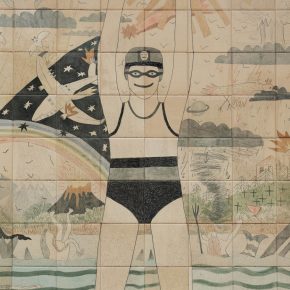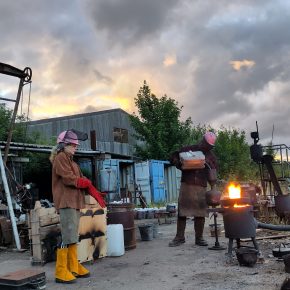Studio conversation with studio holder Aurélien Froment
As an artist, you have a long history with photography and film and I know that you are teaching at Edinburgh College of Art as well as having the studio here, a large part of which looks like a library, please tell me about the studio.
Like every artist, I need a space to organize my ideas. A studio is way to keep all the work and ideas in one place, to be able to both access it when needed, and to make space for new ones.
And is it useful to have the workshop facilities here?
Of course, although I would love to use it more. The way I work involves preparation and planning, then go out there, to film or photograph – often a short and focused time – then come back here to edit the material. The large metal panels that you can see here allow to unfold ideas, and that needs a bit of space. Another side of my work happens in the exhibition space itself. That’s where the preparation I have done allows me to feel free, sometimes improvise and work in dialogue with the space. Where the work which has been carefully prepared here is going live and will be seen by people.

You have a project filmed in Senegal named Non-Aligned (Non Alignés), what does the title mean?
It refers to the political history of Senegal. I worked with a group of people who are passionate with Indian culture, in Dakar. They are people of Dakar, including Somnath Mukherjee, who traveled the world from Calcutta to Dakar in the 1980s and, as there was a lot of love for Bollywood movies in Dakar, stayed there to share his knowledge of music, singing and dance inspired by those films. I was invited to work with them and we filmed some dances and songs from their repertoire.
That relationship between India and Senegal came out during the Cold War, as an alternative to the East-West divide. That’s what allowed Somnath Mukherjee to travel to Senegal, that’s what’s allowed people from Senegal to travel to India for cultural reasons during the 1980s. This is the historical backdrop of these films. Although the project collapsed, something that survived through Mukherjee’s teaching and involvement with local communities.
You travel a lot, you filmed in Senegal, but also in Sardinia, how did you find your stories?
In Dakar I was invited by curator Sumesh Sharma who I worked with in India, they imagined someone who was not Senegalese, and not Indian, to be in the middle of it. It was interesting. I’ve never been to Senegal before and my knowledge of Bollywood film was very limited too, so I was like a foreigner in multiple ways. But I also fell in love with their love, for music and dance, so I could identify in some ways to what they were doing, working with another culture.
With Sardinia, some research took me there. I was interested polyphony. I was imagining a voice that could be multiple… imagining a body speaking three different languages simultaneously. It’s a poetic image rather than something that exists, although some people can sing with their voice and with their throats simultaneously, like in Siberia. In Sardinia, there are some musicians who play launeddas, one of the most ancient musical instruments in Europe. launeddas consist of three reed pipes, with three different sounds. I was there to meet and work with one of the last musicians who carries on that tradition.
Where can we see your work?
These films have been shown in multiple exhibitions in Belgium, in France, Poland, in art galleries and museums as well as in film festivals. Allegro Largo Triste, the Sardinian film, was in competition at the Cinema du reel in Paris and at the Berwick Film & Media Arts Festival. Part of it will be included within a forthcoming solo exhibition in Paris next month.
The Senegalese movies have been shown in Poland, in France, in the US and the UK. What’s interesting is that they are foreign films everywhere. Although they feature Bollywood dances and songs, they are foreign films in India because they were made in Senegal, with Senegalese performers. They are foreign in Senegal because the language is Hindi, and there are twice foreign in Western countries.
Do you have anything ongoing now?
I’m working on a new film and two exhibitions. In July, I am presenting the work of Pierre Zucca, a French photographer who was working on film sets in the 1960s, at Les Rencontres d’Arles in France. The exhibition consists of 180 works of his that I selected. I am also making films of his photographs, and some of my images are shown in dialogue with his. Film still photography is a genre of photography that sits somewhere between commercial photography, fiction, and documentary. It’s a slippery one, that’s what I like, its possibilities and ambiguities. It’s part of popular culture and has had influence over many artists as well.
The second film I’m working on is about language, perception, the difference between hearing and listening… It will be filmed at the Anatomical Museum of the University of Edinburgh. Language and translation, from image to word and vice versa are key to my work. How much we can say about an image with words and how much is missed, and in turn, how words make images.
How does this space work for you so far?
I love it. I’m trying to keep it as flexible as possible. I can unfold everything here and I can see it all… I work with large quantities of material, texts and images. I am going through many stages to process that, to select and choose and to make. The computer screen is too small to see more than two images at the same time, this is why there is that big magnetic wall here, an extension of the screen, my playground.
Studio conversation with studio holder Aurélien Froment, April 2023
More details about Aurélien Froment’s work here:




